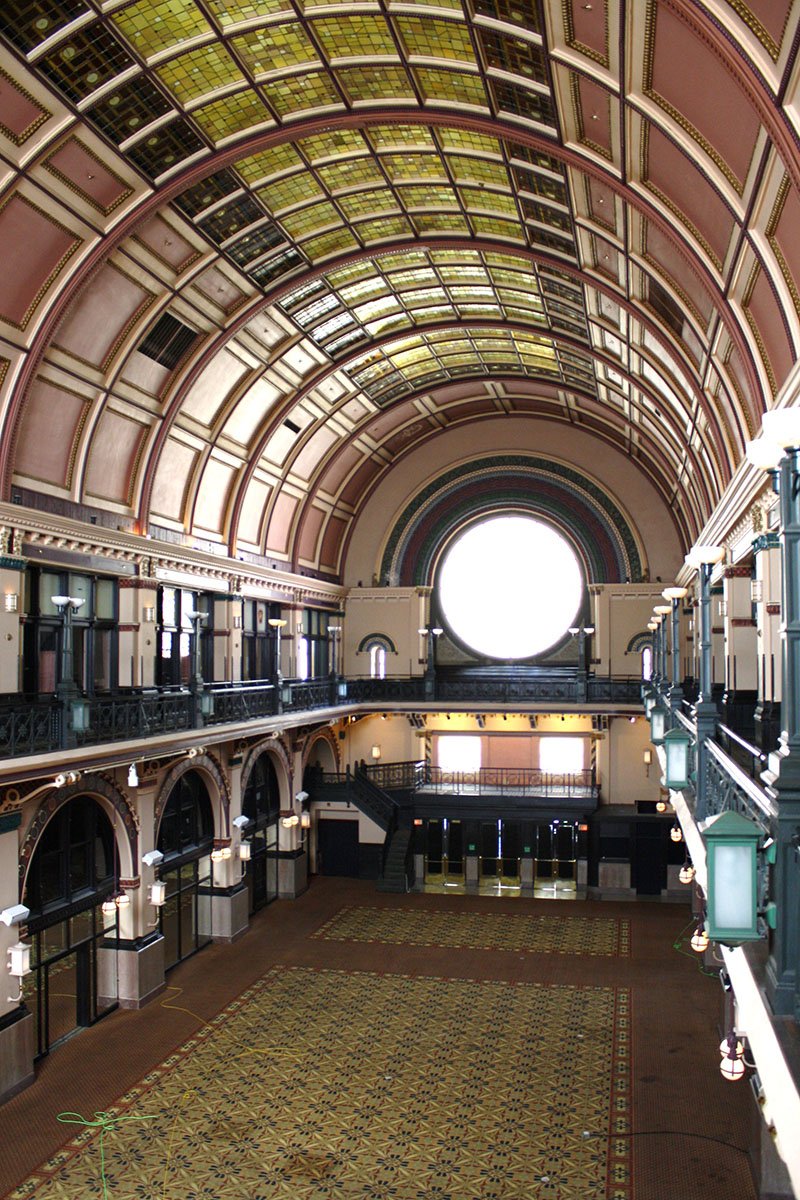Have you been to Union Station downtown lately? It’s come back to life. Over the past seven years, the City of Indianapolis has rehabilitated the immense complex and recruited new tenants. Brad Hartz and Jo Lynn Garing of the Indianapolis Local Public Improvement Bond Bank, which manages the station, say that the leasable portions of the property are now 95% occupied. For the many residents of the city and state who consider the station an essential part of the history of Indiana and its architecture awe-inspiring, this will come as good news.
Union Station symbolizes Indianapolis’ early emergence as a major rail center of the Midwest and as an innovator in rail travel. In 1853, only six years after the first railroad reached the capital city, five competing rail lines cooperated in building the first union depot in the United States on the site of the current station. Indianapolis’ economy mushroomed after the Civil War, as wholesale firms located near the station, and industries established their plants on nearby rail spurs. Freight and passenger traffic grew steadily. In 1886-88, a majestic new Union Railway Station was constructed at Illinois and Jackson Place, designed in the fashionable Romanesque Revival style and built of red brick, granite, and sandstone. By 1910, 200 trains per day were passing through the station. Soon after, an immense new elevated train shed and concourse building covering seven acres was constructed south of the 1888 station to accommodate the ever-growing numbers of passengers and to separate trains from north-south wagon and automobile traffic. When the new expansion was completed in 1922, six million travelers per year were passing through Union Station, efficiently dispatched to and from their trains through a concourse with terra cotta walls and rare Art Nouveau decorative panels.
After a high point in rail travel was reached during the 1920s, traffic began a slow decline as millions of Americans purchased automobiles and took to new state highways for their trips. A revival occurred during World War II, when restrictions on gasoline and domestic consumption led to a boom in Union Station’s life as the center of Indiana travel. After the war, the automobile and airplanes became the undisputed ways to visit other places, and Indianapolis’s long sway as the Railroad City came to an end. By 1967, only 16 trains per day passed through the station and by 1975, only two.
But no one really wanted the symbol of the city’s rail past to be demolished. The City of Indianapolis and dedicated volunteers floated several plans for its revitalization, and finally in the early 1980s, the City acquired the property. A plan was worked out for the station’s redevelopment and restoration as a festival marketplace, which opened under the sponsorship of local developer Robert Borns in 1986. The marketplace concept, involving an expenditure of $48 million, converted the 1888 station into a restaurant hub, most of the train shed into a food court, the concourse level and east building into shops, and the west building into a 276-room hotel. In the early 1990s, the marketplace closed, and the City began to search for new uses. In 1999 Crowne Plaza took over the hotel, and in 2000 the administration of Mayor Bart Peterson began to search for tenants who could occupy enough space to pay the operating costs of the station.
One of the biggest successes was signing the engineering firm of R.W. Armstrong to occupy much of the former train shed in 2002. Today, the headquarters of the engineering company shares with the architecture firm A2SO4 an elegant space spanned by steel columns and girders and lit by the train shed skylights. A2S04 president Vop Osili says that both firms find that their unusual space, with irregularly placed office pods and subtle colors contrasting with the rectilinear shed structure, is a compelling marketing tool. He and his colleagues also find that the mixture of historic architecture and contemporary design enhances their creativity.
Crowne Plaza now leases and uses the richly restored Grand Hall of the 1888 Station as a ball room and finds that the former waiting room is in great demand for weddings, dinners, and receptions. The hotel uses rooms in the former concourse as convention meeting rooms and uses the names of the 10 former rail lines that once disembarked passengers in the train shed above. In the east building, the Mexican Consulate, Bands of America, the Pacer’s Academy, and several other non-profits now lease space. Brad Hartz believes that with construction of the new Lucas Oil Stadium, demand for tenancy in Union Station can only increase.

Former Waiting Room, Union Station, 2013. James Glass
